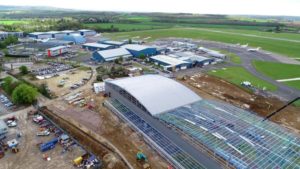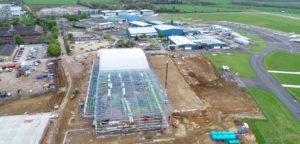Work is progressing on a major expansion at London Oxford Airport in the UK that includes a new hangar, helipads and SAF-ready fuel farm.
Central to the project is a 63,000ft² (6,000m²) 140m long hangar with two bays including rear offices, stores and workshops. The building is expected to be complete by November.
The hangar will be capable of accommodating up to six Bombardier Global, Gulfstream or Dassault Falcon Jet models simultaneously and is the fifteenth hangar at the airport. It is the first facility to be built in a new development zone to the north of the airport’s original site.
It will be used predominantly by established tenants that are currently using buildings originally built during WWII, along with a number of larger business aircraft for which there has been limited capacity at Oxford.
The airport plans to progressively replace the 80-year old hangars with new, bespoke facilities, providing turnkey solutions for clients.
BAI talked to with James Dillon-Godfray, head of Business Development at London Oxford Airport to find out more about the project.
Why have London Oxford Airport decided to expand now?
The development program has been prompted primarily by the last 18 months of economic decline. The pandemic has been a catalyst for us to get on with things we’ve been wanting to do for many years. The economic slowdown, and the need to make a bounce back recovery prompted our owners to say, ‘Come on, let’s get on with some of these things and pursue the evolution of the airport and take it to the next stage’. I think it’s arguable that to a small degree Brexit has been a catalyst to get on with things too.

Have you seen a growth in business aviation customers recently?
Things are picking up again. We’ve had various lockdowns in the UK during the course of the last year and that’s curtailed most normal business travel and travel for leisure. But since May, we’ve seen a real increase in activity.
You can certainly sense that things are picking up a bit, despite the fact that there are still significant constraints on travel.
A new fuel farm ready for sustainable aviation fuel (SAF) is being built – has there been a demand from customers for this?
People are talking about SAF now. But SAF is still typically three to five times more expensive than normal Jet A one, which is a massive disincentive to buy SAF. Nevertheless, I think moving forward, it’s going to be something that people will want to have the option to be able to buy, but the demand will initially be limited compared to Jet A.
We’re going to be ready to have it when the demand is there, so if we decide to go ahead and put it in, we can get that done within months rather than years.

How important is this project for the future vision of the airport?
Around 60% of our turnover derives from property rentals. Once we fill up the available stock of buildings that we have we can’t make any more from hangarage and we can’t make anything more from property rental.
It’s critical that we build more capacity to grow the business, and to entice more companies to come and reside here.
We’ve got a situation where our resident companies want to expand and for that they need more space. We’ve also got other companies who would like to set up here. But they can’t because we’ve got nothing to offer them. It’s a double whammy of not being able to move forward at all, until we build.
As soon as Hangar 15 is finished in November, it will be full. So, we have to start all over again because the demand is now.
When will the airport’s expansion be finished?
I don’t think it will ever be finished. I think we’ll carry on meeting demand, so long as we’ve got a footprint available to do that. We’ll carry on building more facilities until we run out of space. There’s lots of potential here.





